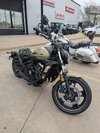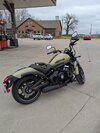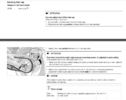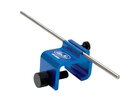- Joined
- Sep 25, 2009
- Messages
- 2,401
- Age
- 69
- Location
- West Des Moines, IA
- Bike
- Something 2 wheels
- 2025 Miles
- 000265
I WAS thinking of waiting until I just showed up at LOCSTOC... but I just had to say something.
A very few of you noticed I changed my avatar pic. There's a reason for that.
On Friday I did a RIDE and RIDE. No I didn't ride my AK and trade it in. I still have the Kymco. But I did ride with @ardykay54 who volunteered to drive all the way from Eastern Iowa to Central Iowa, then give me a ride half way between us.... well, a little closer to Russ than to me actually.
My wife told me she wanted me to have a more common brand that has a dealership in town. So this is HER fault! Yeah, I'm going with that.
The local Honda shop closed down and there is now a new one on the far side of the metro area as part of a multi-brand dealership. But Honda doesn't have anything I'm interested in right now. I want to stay with the same weight and similar engine size class as my AK and a low seat height. There are no Super Scooters around other than my AK so that means going back to throwing my leg over a seat... thus the desire for a low seat height. After looking around for a few weeks one bike seemed to stand out to me. Though I'd have to violate several preferences I've adopted. One is not having a step through in front of the seat to save my hips and knees. Another is going back to a manual transmission (I've really enjoyed no shifting). And the big one is to avoid a chain final drive. And another big one is having forward foot controls. I've just had no desire to deal with a chain. I know it can be less costly and more efficient, but there is constant regular maintenance cleaning/lubing the chain as well as adjusting more often than a belt final drive. A drive shaft final drive is the easiest for maintenance but the worse for efficiency (not that it matters for conservative riding). A belt final drive is a little bit of maintenance and in the middle for efficiency. Chain final drive is more minor maintenance but the most efficient.
After searching all around within 200 miles (figured I would find something within that range) I found the lowest pricing on a NEW hold over 2024 model in Cedar Rapids. Though I don't recommend doing business with that dealer unless you really pay attention to the details and are willing to give a little to get ANYTHING. Their price was lower than the 2022 models I found with reasonably low miles. It beat any other bike for the same model year by almost $1500 (though much of that difference was made up for by the excessive markup this dealer demanded). And this bike only had 26+ test ride miles. I made it 34 miles.
I bought a Kawasaki Vulcan S ABS sport cruiser.
It does have a chain final drive but I've read that chains are a lot better than they were the last time I had a chain final drive on a bike (my first bike in 1980 and second bike in 2002). It also has forward foot controls but they are not as forward as many other cruisers. I'd say at the back end of the range for forward foot controls. It is 498 lbs wet. I rode it home 136 miles Friday afternoon. No windshield but it really didn't feel like I needed one. No buffeting even though there was some wind. Just a smooth stream of air... forceful but not bad. I've had worse on bikes WITH a shield. This Vulcan S has a 649cc Ninja 650 engine, thus the SPORT cruiser designation. And it really likes to rev high. It is a 6 speed transmission. Though I did have to keep the RPM under 4000 (53 MPH) so I kept to county roads all the way home. Break-in is 250 miles under 4000 RPM, up to 400 miles under 6000 RPM (slower Interstate speeds!), and moderate riding up to 600 miles for the initial oil/filter change to dump the factory cut-in oil. I now have another 50 miles to go to keep it under 4000 RPM. And it is really hard to keep it under that! It just wants to go faster. The seat is very comfortable, but not as comfy as the Corbin seat I had previously. I didn't feel the need to stop all the way home, though I did in order to answer a text from my wife a few times (I keep telling her to do a phone call if she wants to contact me when I'm riding). A low seat at 27.9 inches so I don't have to lift my leg much to climb on. It's a solo rider so no passengers.
Already ordered Shad side cases and mounts as well as luggage rack with rider back rest. I needed to also order replacement rear frame tubes that includes the passenger foot peg bracket for the Shad mounting. But I found an open box new set on eBay for a very reasonable price. Just need the peg mount to be there but don't need the pegs.
I'm debating what to do for a tank bag. Thinking a smaller magnetic one is enough for what I need.




A very few of you noticed I changed my avatar pic. There's a reason for that.
On Friday I did a RIDE and RIDE. No I didn't ride my AK and trade it in. I still have the Kymco. But I did ride with @ardykay54 who volunteered to drive all the way from Eastern Iowa to Central Iowa, then give me a ride half way between us.... well, a little closer to Russ than to me actually.
My wife told me she wanted me to have a more common brand that has a dealership in town. So this is HER fault! Yeah, I'm going with that.
The local Honda shop closed down and there is now a new one on the far side of the metro area as part of a multi-brand dealership. But Honda doesn't have anything I'm interested in right now. I want to stay with the same weight and similar engine size class as my AK and a low seat height. There are no Super Scooters around other than my AK so that means going back to throwing my leg over a seat... thus the desire for a low seat height. After looking around for a few weeks one bike seemed to stand out to me. Though I'd have to violate several preferences I've adopted. One is not having a step through in front of the seat to save my hips and knees. Another is going back to a manual transmission (I've really enjoyed no shifting). And the big one is to avoid a chain final drive. And another big one is having forward foot controls. I've just had no desire to deal with a chain. I know it can be less costly and more efficient, but there is constant regular maintenance cleaning/lubing the chain as well as adjusting more often than a belt final drive. A drive shaft final drive is the easiest for maintenance but the worse for efficiency (not that it matters for conservative riding). A belt final drive is a little bit of maintenance and in the middle for efficiency. Chain final drive is more minor maintenance but the most efficient.
After searching all around within 200 miles (figured I would find something within that range) I found the lowest pricing on a NEW hold over 2024 model in Cedar Rapids. Though I don't recommend doing business with that dealer unless you really pay attention to the details and are willing to give a little to get ANYTHING. Their price was lower than the 2022 models I found with reasonably low miles. It beat any other bike for the same model year by almost $1500 (though much of that difference was made up for by the excessive markup this dealer demanded). And this bike only had 26+ test ride miles. I made it 34 miles.
I bought a Kawasaki Vulcan S ABS sport cruiser.
It does have a chain final drive but I've read that chains are a lot better than they were the last time I had a chain final drive on a bike (my first bike in 1980 and second bike in 2002). It also has forward foot controls but they are not as forward as many other cruisers. I'd say at the back end of the range for forward foot controls. It is 498 lbs wet. I rode it home 136 miles Friday afternoon. No windshield but it really didn't feel like I needed one. No buffeting even though there was some wind. Just a smooth stream of air... forceful but not bad. I've had worse on bikes WITH a shield. This Vulcan S has a 649cc Ninja 650 engine, thus the SPORT cruiser designation. And it really likes to rev high. It is a 6 speed transmission. Though I did have to keep the RPM under 4000 (53 MPH) so I kept to county roads all the way home. Break-in is 250 miles under 4000 RPM, up to 400 miles under 6000 RPM (slower Interstate speeds!), and moderate riding up to 600 miles for the initial oil/filter change to dump the factory cut-in oil. I now have another 50 miles to go to keep it under 4000 RPM. And it is really hard to keep it under that! It just wants to go faster. The seat is very comfortable, but not as comfy as the Corbin seat I had previously. I didn't feel the need to stop all the way home, though I did in order to answer a text from my wife a few times (I keep telling her to do a phone call if she wants to contact me when I'm riding). A low seat at 27.9 inches so I don't have to lift my leg much to climb on. It's a solo rider so no passengers.
Already ordered Shad side cases and mounts as well as luggage rack with rider back rest. I needed to also order replacement rear frame tubes that includes the passenger foot peg bracket for the Shad mounting. But I found an open box new set on eBay for a very reasonable price. Just need the peg mount to be there but don't need the pegs.
I'm debating what to do for a tank bag. Thinking a smaller magnetic one is enough for what I need.




Last edited:






 But then I'll have to re-learn how to fish.
But then I'll have to re-learn how to fish.